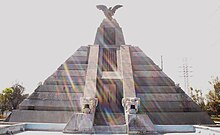 The north side of the monument in 2006 | |
 | |
| 19°27′52″N 99°08′33″W / 19.46444°N 99.14250°W | |
| Location | Mexico City, Mexico |
|---|---|
| Designer | Francisco Borbolla (engineer) and Luis Lelo de Larrea (architect) |
| Type | Pyramid |
| Material | Concrete |
| Height | 50 meters (160 ft) |
| Beginning date | 1930 |
| Completion date | 1940 |
| Opening date | 12 October 1940 |
| Dedicated date | Día de la Raza |
| Dedicated to | La Raza |
The Monumento a la Raza is a 50 meters (160 ft) high pyramid in northern Mexico City. It is located in the intersection of Avenida de los Insurgentes, Circuito Interior and Calzada Vallejo, in the Cuauhtémoc borough.
The monument consists of three superimposed truncated pyramids decorated with several sculptures on the sides and an eagle on the tip. The pyramid was designed by Francisco Borbolla and the stone sculptures and its layout by Luis Lelo de Larrea. Many of the artworks were created during the Porfiriato period. The copper-and-steel eagle was cast by French animalier Georges Gardet and the bronze high reliefs were created by Mexican sculptor Jesús Fructuoso Contreras. The eagle was originally intended to be placed on top of the never-completed Federal Legislative Palace—later replaced with the Monumento a la Revolución in downtown Mexico City—, while the reliefs were based on those created for the Aztec Palace, presented in the Mexican pavilion of the 1889 Paris Exposition.
Its construction started in 1930 and was completed ten years later. It was inaugurated in 1940, on the Día de la Raza (Columbus Day), and it is dedicated to la Raza—the indigenous peoples of the Americas and their descendants. Even though the monument drew criticism from writers and historians for its choice of Porfirian components and caricaturizing Mesoamerican architecture, it contributed the area's to be known as "La Raza" and the naming of several nearby structures. The monument has been abandoned since at least 2022, as it has received minimal maintenance from the city government.